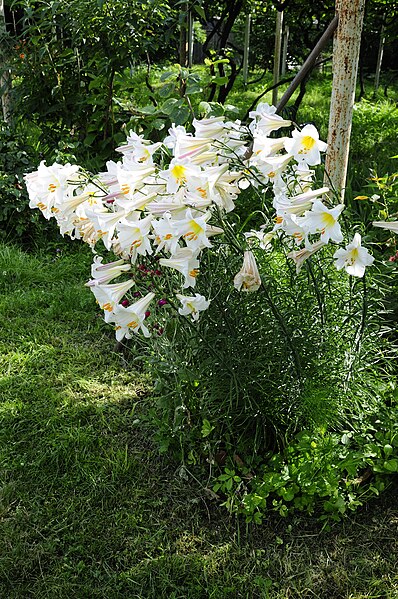Steven Desmond on the flowers to concentrate on at the moment, from the always-popular lilies to the dahlias which have gone from no-nos to must-haves.
Most of our bulb and tuber planting in the garden is done in the cool mists of autumn, but there are always some special duties reserved for the spring. For that reason, they often get overlooked in the general call to arms as everything in the garden leaps forward on a daily basis. Let us turn advisedly to the planting of dahlias and lilies as a deliberate act rather than a last-minute bodge.
The dahlia, having gone from no-no to must-have in modern times, is simple enough to cultivate. We all thumb the lurid pages of catalogues in search of suitable cultivars. This can be a visually shattering experience, but steel yourself to the task, as fortune favours the brave. Each to their own, of course, but I do favour big groups of something magnificent like Karma Lagoon, tall and richly violet, at intervals across the sightline.
If floral size beckons, but you wish to retain your eyesight, I propose Café au Lait, a fluffy monster in fawny pink. Should monochrome discipline appeal, try Twyning’s After Eight, which has nothing to do with either tea or chocolates, but is a very good single-flowered doer.
This being the busy time, I keep to a simple routine. Those bunches of tubers that were dried off at the end of last season and stuck in a bucket in a shed are now brought forth and simply potted up in a general-purpose medium and watered. The object of this is to get the shoots growing, which will happen soon enough.
It’s best to keep the plants in a frost-free glasshouse. Once the shoots are 4in high, you can either divide the clump by neatly severing it into sections of tuber and root and repot individually or take the new shoots off as cuttings. They’re very willing to root. Be strict with your labelling or you’ll soon be in a muddle. And don’t keep them too warm or you’ll enter the dark tunnel of pest control.
Lilies seem always to have maintained their social position. This has nothing to do with the challenge of growing them, as it’s simple enough. I’m often surprised at how few people do it. Growing them in pots is a little more labour-intensive than gazing at their beauty in a woodland garden, but no more so than any other outdoor potted plant. Again, the first task is selection, in which exercise the only difficulty is the wide range that spreads across the pages of every brochure.
I like lily flowers to be but little removed from their wild ancestors, so I have a few favourites to suggest. Among these is Lilium regale, that Edwardian sensation the plant hunter ‘Chinese’ Wilson thought worth breaking his leg for to introduce to us.

Lilium regale (Pic: Philipp Weigell)
Another from that heroic age is L. auratum, the ‘golden-rayed lily of Japan’, for my money far more impressive than any number of modern dwarf novelties. As scent is a priority for me, L. longiflorum is a must with its delicious morning perfume.
To grow these big lilies in pots, we must start with a container of sufficient size. I favour big terracotta pots, against which white lilies look so well. I put some lumps of stone in the bottom, not for drainage, but for a bit of extra stability. Three bulbs in a 10in pot always seems about right: I want the flowers to hang a little around the edge towards my nose. Use John Innes No. 3 compost to keep them going through the season.
Lilium longiflorum will need to be planted good and deep in the pot as it’s a stem-rooter. L. auratum needs acid soil, so use the ericaceous version of the same compost. A layer of grit across the surface neatens things up and keeps them that way. When the green shoots are a few inches tall, bring the pots to their intended quarters and construct a simple framework of canes and raffia for nonintrusive support. L. longiflorum is a bit on the delicate side, so watch out for cold nights and take precautions, although there’s no need for the shroud of white fleece.
All these tall fellows are naturally a bit rickety in windy weather, so choose your site with care: a sheltered corner is ideal, with several hours of sun during the day. The effect is theatrical when they come into flower, so put them somewhere near an elegant seat to allow yourself an Alma-Tadema afternoon.
Steven Desmond is a freelance landscape consultant, specialising in the conservation of historic gardens




